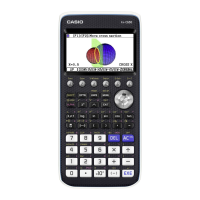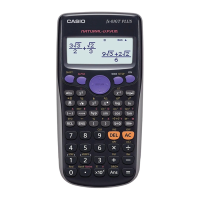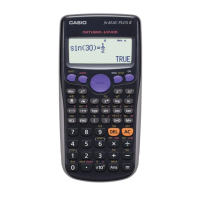Chapter 2: Main Application 84
• “tail setting” displays the probability value tail specification, and Left, Right, or Center can be specified. Enter
the following values or letters to specify:
Left: −1, “L”, or “l”
Center: 0, “C”, or “c”
Right: 1, “R”, or “r”
When input is skipped, “Left” is used.
• When one argument is omitted (resulting in three arguments), Tail=Left.
• When two arguments are omitted (resulting in two arguments), Tail=Left,
μ
=0.
• When three arguments are omitted (resulting in one argument), Tail=Left,
σ
=1,
μ
=0.
• When “tail setting” is Center, the lower bound value is returned.
Calculation Result Output:
x
1
InvN, x
2
InvN
Example: To determine the upper bound value when tail setting = Left, area
value = 0.7,
σ
= 2,
μ
= 35
u tPDf [Action][Distribution/Inv.Dist][Continuous][tPDf]
Function: Returns the Student’s t probability density for a specified value.
Syntax: tPDf(
x, df [ ) ]
Calculation Result Output:
prob
Example: To determine the Student’s t probability density when x = 2, df = 5
u tCDf [Action][Distribution/Inv.Dist][Continuous][tCDf]
Function: Returns the cumulative probability of a Student’s t distribution between a lower bound and an upper
bound.
Syntax: tCDf(lower value, upper value,
df [ ) ]
Calculation Result Output: prob, tLow, tUp
Example: To determine the Student’s
t distribution probability when
lower value = 1.5, upper value = ∞, df = 18
u invTCDf [Action][Distribution/Inv.Dist][Inverse][invTCDf]
Function: Returns the lower bound value of a Student’s t cumulative distribution probability for specified
values.
Syntax: invTCDf(
prob, df [ ) ]
Calculation Result Output: xInv
Example: To determine the lower bound value when
prob = 0.0754752,
df = 18
u chiPDf [Action][Distribution/Inv.Dist][Continuous][chiPDf]
Function: Returns the χ
2
probability density for specified values.
Syntax: chiPDf(
x, df [ ) ]
Calculation Result Output: prob
Example: To determine the χ
2
probability density when x = 2, df = 4

